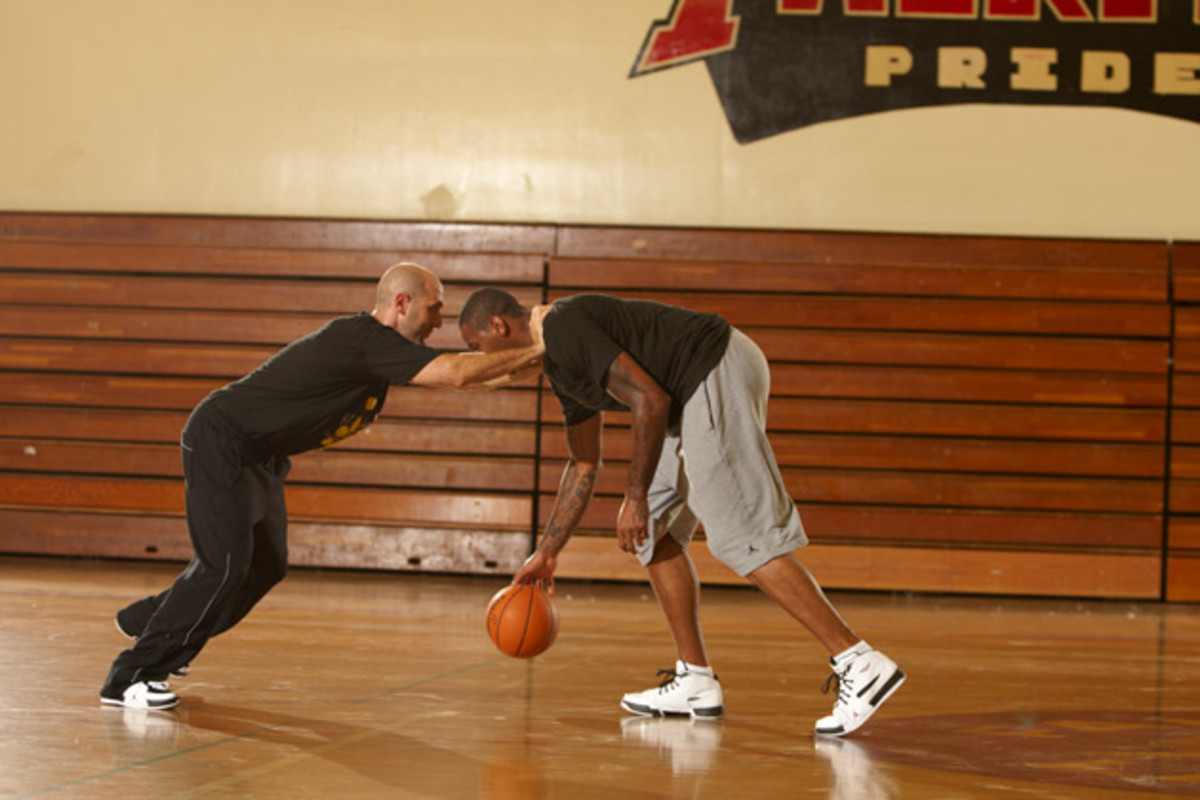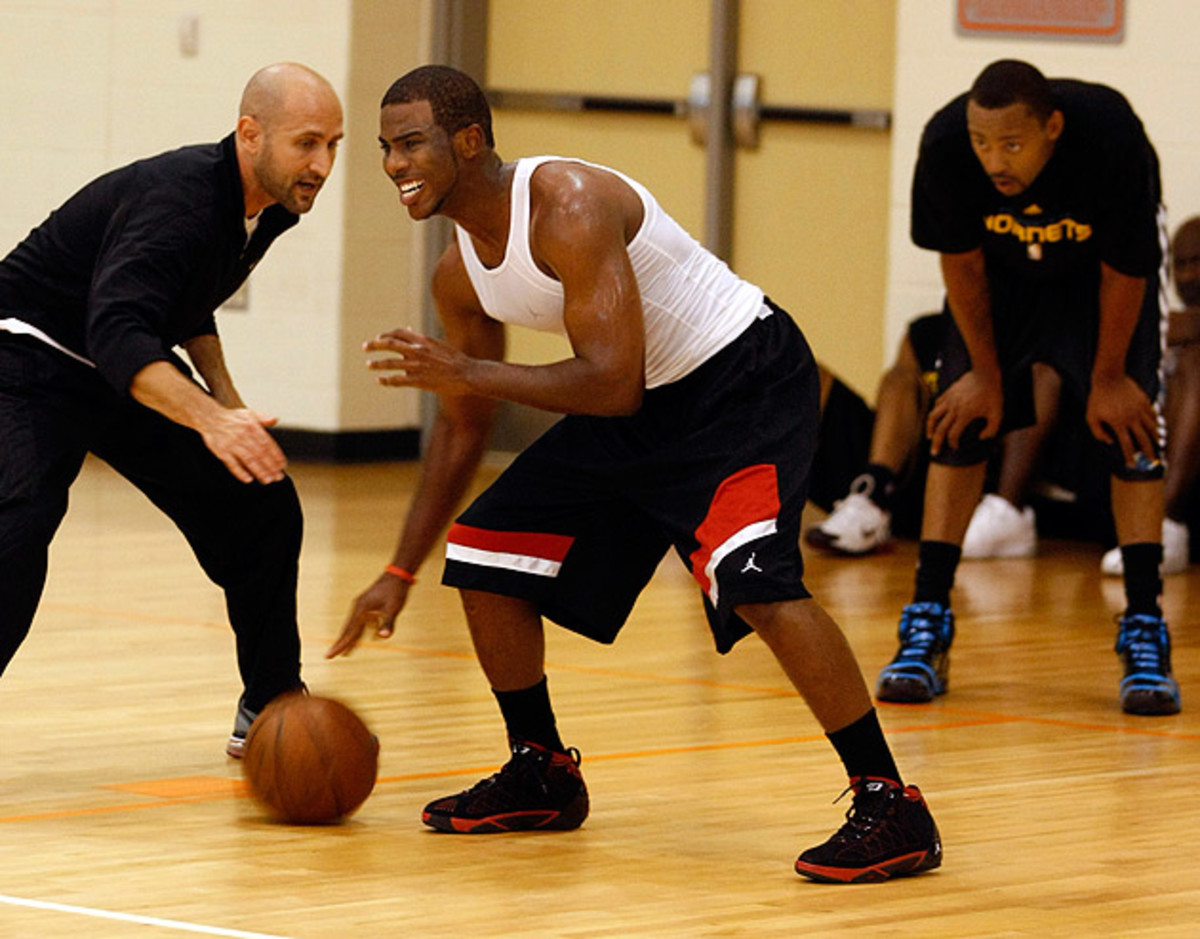Speak Softly, Carry Big Game: Hoops Whisperer Idan Ravin

It’s a warm Tuesday during the second week of the NBA playoffs, and the man known throughout the league as the “Hoops Whisperer” is in his Manhattan apartment, getting ready to watch the Wizards take on the Bulls on TV just like any other fan anywhere else in the country. Some might think Idan Ravin would be on the road at this time of year, chasing his megastar athletes from game to game like other high-profile personal trainers. But Ravin, who has worked with nearly every luminary in the sport, including LeBron James, Carmelo Anthony, and Kobe Bryant, is at home, glued to his TV and cell, watching his players through miles of airwaves and waiting for any texts, emails, or phone calls that might come through from those who want his professional opinion, which has become as sought-after in the NBA as uncontested layups.
“It’s a very delicate, sensitive time,” Ravin says. “I try to keep in touch as much as possible with my players, but I’m not sending them 17 pages of scientific evaluation. It might just be a one-line text like, ‘Command the ball.’”
Commanding the ball, though, is not something Ravin has ever experienced as a pro or collegiate athlete. A former attorney, Ravin never played serious hoops after high school. Despite this omission on his CV, or perhaps because of it, Ravin has risen among the ranks of personal trainers to become one of the most respected—and unconventional—coaches in the game. “I don’t come form the world where you regurgitate everything you’ve been taught and told, so that everything becomes boring,” he says. “I believe in doing things different. I don’t believe the peanut butter always has to go to the jelly.”
RELATED: From the Hoops Whisperer: The Legend of Kevin Durant
But what the peanut butter does go with, in Ravin’s own analogy, is a bit of a mystery, as the 42-year-old trainer is tightlipped about how he works with his celebrity clients—an impressive grouping that includes many in this year’s playoffs, such as Kevin Durant, Dwight Howard, Stephen Curry, and Chris Paul. After all, there’s a reason why Ravin is called the “Hoops Whisperer,” and he isn’t about to disclose what he murmurs into the ears of some of the country’s best basketball players to help turn them into superhuman athletes.

Despite his reticence, though, Ravin is willing to discuss one signature drill—perhaps only because half the country has already seen it in a Nike commercial. In that advertising spot, Ravin chucks tennis balls at a dribbling Carmelo Anthony, who expertly catches them with one hand and fires them back to his trainer. Ravin says the drill teaches athletes to master the skill of dribbling instinctually while dealing with unexpected distractions. “I would never tell a player Let’s catch and throw jump shots because the game is never played at that speed,” Ravin says. “Instead, I try to increase the pace, resistance, intensity, and level of focus.”
Similarly, Ravin says he often tries to recreate the sensory overload in training that occurs during real-live games, having his players, for example, take jump shots with their eyes closed. “This lets you identify your depth perception,” Ravin explains. “It tells the brain to remember the distance, so if there’s a hand in your face or someone is trying to block your line of sight, it doesn’t matter because you already know the distance to the hoop.”
The emotional link
Ravin’s drills may be unique, but it’s not just that factor that separates the articulate, thoughtful trainer from the rest of the coaches in the league. Visit his personal website (idanravin.com), and his splash screen features a quote from a Polish physician who, says Ravin, saved hundreds of children during the Holocaust. “What matters is not what one plays with, but rather how and what one thinks and feels while playing,” the quote reads on Ravin’s site, in the kind of graffiti script you might find decorating an urban basketball court.
VIDEO: Idan Ravin on Pressures of High Profile NBA Athletes
In this sense, Ravin seems to have developed a finely tuned emotional lens that he turns on his players and that he relies on far more than any specific training protocol or philosophy. “If you’re asking if I have a formula, the answer is no—it’s more of a feel,” Ravin says. “I’ve known all my players for so long, I can say, That doesn’t look right, or He’s not moving right.”
When Ravin sees his players compete in a championship game, he says he’s not looking for overt signs of their physical prowess, but for subtler emotional cues such as personality ticks and underlying psychological traits. This was the certainly case in the first-round Washington-Chicago matchup, in which two of Ravin’s guys—Joakim Noah of the Bulls and Trevor Ariza of the Wizards—were playing. “I watched it from more of an emotional standpoint rather than a physical way,” Ravin says of the game. “A contrast of two people who express themselves very differently—one an intense vocal fire starter, the other, a calmer quieter technician.”

Based on this type of psychological assessment, Ravin says he tailors and reformulates his recommendations of how athletes should play in the championships. Watching all-star Houston center Dwight Howard in the first round, Ravin observed, “Dwight’s in a tough place because it’s not like he crowds the ball. He needs to get the ball, so a lot hinges on him having the larger voice to ask for the ball. But that’s hard when you’re out there working with other stars—he has to have a dominant voice out there to command the ball.”
This time of year, Ravin says he urges his players to use the extra time they have between games to become more introspective. “I always encourage them to prepare on a team level and an individual level,” the 42-year-old trainer says. “You have your team practices where you’re working on offense and defense. But then there are things you have to work on your own, like if in your last game you missed shots or weren’t playing well, you have to evaluate you own game.”
RELATED: Z's = W's: Want to Max Out Your Performance? Take a Nap
In evaluating games, Ravin says he’s always there to help his players and tries to stay in touch with them as much as possible during the playoffs. But what exactly the trainer says to his players during this time of year, when the NBA pressure cooker heats up, is an enigma, as Ravin remains vague about his advice. “I am always a text, email, or phone call away,” he says. “I wear many hats with my players and believe that helping someone become better happens in many places and in many ways, not just in the gym.”
From law to LeBron
More than 15 years ago, few people in the NBA had ever heard of Ravin, who, at the time, was a self-described “unhappy lawyer,” following the career path he thought he should as the son of two immigrants parents. “I remember just putting my head down and praying that a lightening bolt would impale itself on my desk and God would give me a blueprint with what do with my life,” Ravin says of his years as an attorney. “But that never happened.”
Yet something different happened: Ravin saw a flyer one morning at the Y where he worked out advertising for a boy’s basketball coach. He volunteered—and quickly transformed the team. “The response from parents was like, ‘Wow, what are you doing? I’ve never seen my kids engage like this in my entire life,’” Ravin says. “And I begin to think that maybe I was a good teacher, that I inherited the teaching genes from my parents.
Ravin’s coaching at the Y soon led to him helping a few guys at the gym, some who played pro ball overseas, with their drills and shots. Word of Ravin’s work on (rather than in) the court eventually leaked into the NBA, and a few league players started showing up to the attorney’s informal practices. He trained them for free at first until his mother made him realize that the players valued him and that basketball, perhaps, was the lightening bolt he’d been praying for. “It wasn’t something where you wake up one morning and want a career change,” Ravin recalls. “It was more like, Oh my god, I have to do something that I enjoy, I have to get out of the office. It was more out of desperation.”
Desperation may have driven Ravin to start coaching, but it was his passion for basketball that has made him good at it. “I fell in love with the game as a child,” Ravin says. “It was something I could do on my own that didn’t require a lot of money from my parents that they didn’t have.”
Ravin says he taught himself to play basketball and that he never competed beyond high school because, “When the opportunity presented itself to play ball in college, the immigrant response was, ‘What are you going to do with basketball?’” Now that Ravin has done more with basketball than most college players only dream of, he says lack of conventional training doesn’t bother him at all, despite what he calls “rumblings” from others in the NBA.
“I’ve always been an outsider—it doesn’t concern me with what they think,” Ravin says. “Whether they say to me I don’t have a traditional résumé or not, their opinion has no bearing on how I chose to do my work.”
